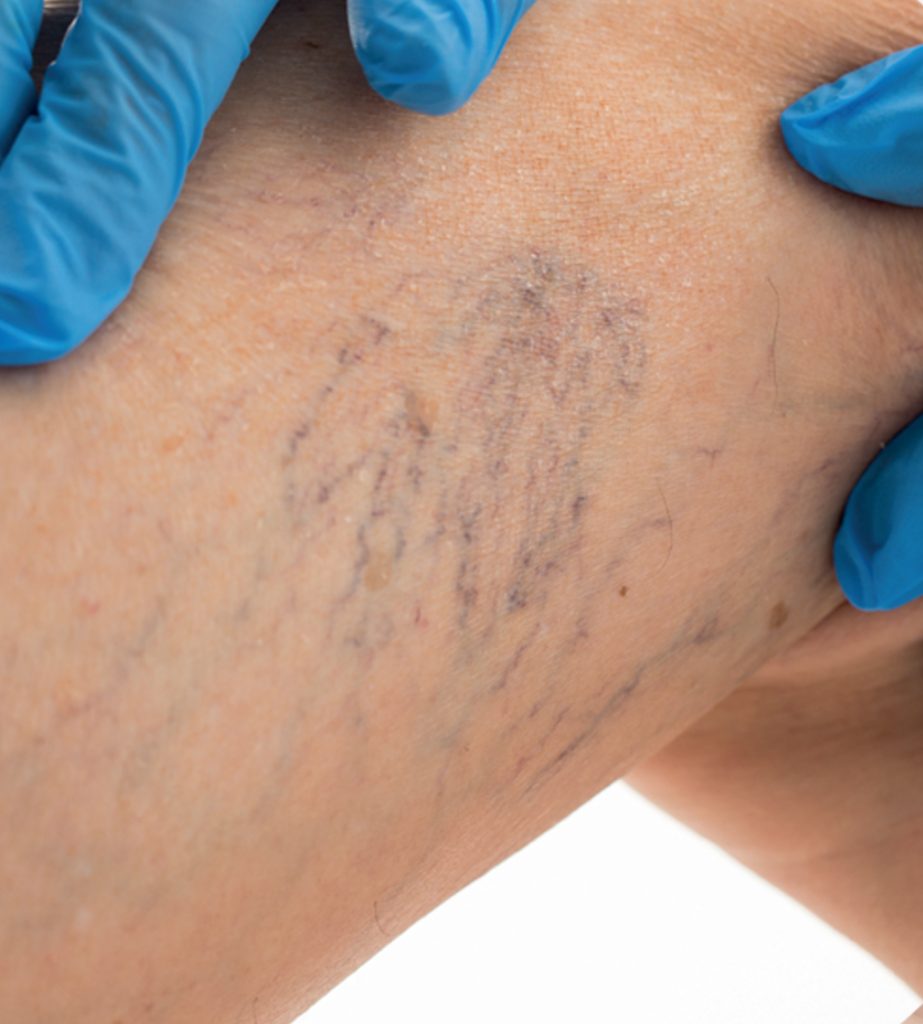
Spider veins (or telangiectasias) are small, dilated blood vessels that are red or purple in colour. They are typically visible through the skin on the face or legs.
Spider veins on the face are usually superficial vessels that respond to laser or light treatment. Those on the legs may be an indication of deeper obstruction or abnormalities of larger and deeper veins in the legs, which may warrant further investigation. They are also often aggravated by gravity and pooling of blood in the legs.
Causes of spider veins on face:
- Heredity
- Rosacea (recurrent flushing and blushing results in permanently dilated small blood vessels)
- Excessive alcohol ingestion
- Female hormones (pregnancy, medication)
- Sun exposure
- Radiation exposure
- Cold exposure
- Thin skin (overuse of steroid creams, skin ageing, newborn babies)
Causes of spider veins on legs:
- Heredity
- Occupations that involve a lot of standing (nurses, teachers)
- Obesity
- Hormonal influences of puberty, pregnancy and menopause
- Birth control pills
- Post-menopausal hormonal replacement
- History of blood clots
- Conditions that cause increased pressure in the abdomen (tumours, constipation, garments such as girdles)
Get rid of spider veins
Underlying causes need to be addressed to prevent worsening of the condition. Vascular laser treatment is safe and effective to treat spider veins. There are several types of vascular lasers that target different blood vessel sizes and are associated with varying levels of pain during treatment. As spider veins are lasered one at a time, the procedure is relatively time-consuming and several treatments using different settings are required. However, vascular laser treatment is non-invasive and thus causes no downtime. Purplish discolouration of the treated vessels will take several weeks to fade.
Although Intense Pulsed Light (IPL) therapy is less expensive and results in less immediate discolouration, it is less effective and more sessions are required. Redness and flushing caused by rosacea can be treated by vascular laser or IPL.
Sclerotherapy involves the injection of a solution directly into the small vessels. The solution irritates the inner lining of the blood vessels, causing it to swell and stick together, and the vessel to seal up gradually. It is a convenient and effective treatment for large areas of branching or fanning spider veins, as each injection can treat many interconnected vessels. Bruising and discolouration are common side effects.
Sclerotherapy may cause skin ulceration if the liquid is inadvertently injected into the surrounding skin when the blood vessel is very fine and difficult to thread. In some cases, sealing up the larger vessels entangles the dilated small vessels. This can be corrected with vascular laser.
Changes in lifestyle habits, such as wearing compression garments, avoiding standing for extended periods, and leg elevation may also help improve the condition.
Don’t ignore the problem
Not only are they unsightly, spider veins may be an indication of, or can lead to, bigger problems if left untreated. Radiation or sun-induced skin damage may progress to skin cancer and excessive alcohol intake may cause liver disease.
Erythemo-telangiectatic rosacea, characterised by intermittent flushing and persistent central facial redness, may progress to chronic inflammatory skin changes such as papulopustular rosacea (pimple-like red bumps that may contain pus) and rhinophyma (development of a large, bulbous nose).
Spider veins together with varicose veins in the legs indicate problems in the larger or deeper veins, such as defective valves in leg veins or previous clot in the deep leg veins. This is called deep-vein thrombosis (DVT), and can lead to swelling, aching, skin discolouration, rash or leg ulcers.







